A godsend for gardeners - the Golden Mother-in-Law tomato: characteristics and description of the variety, cultivation and care
Growing tomatoes on your own plot is not a difficult task, the main thing is to follow an organized care system. But first you need to decide on the variety, because each requires a special approach. We advise you to try the hybrid variety Zolotaya Tescha, bred specifically for the Russian climate with short and cold summers.
Description
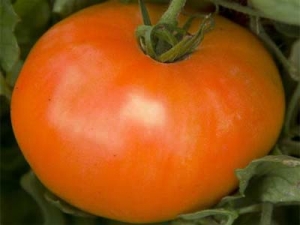 The early-ripening, high-yielding tomato hybrid Zolotaya Tescha is included in the state register of breeding achievements approved for use in Russia since 2008 (code 9252688). The bush is determinate (low-growing) from 80 cm to 1 m in height, weak-leaved, growth slows down after the formation of the fifth inflorescence. The brushes are complex and dense, ripening quite amicably.
The early-ripening, high-yielding tomato hybrid Zolotaya Tescha is included in the state register of breeding achievements approved for use in Russia since 2008 (code 9252688). The bush is determinate (low-growing) from 80 cm to 1 m in height, weak-leaved, growth slows down after the formation of the fifth inflorescence. The brushes are complex and dense, ripening quite amicably.
The variety was bred by the famous agronomist Lyubov Anatolyevna Myazina – specialist in growing tomatoes, fruits and vegetables. Her personal collection already includes more than 25 varieties and about 40 hybrids of tomatoes, some of which are early varieties and are used in industrial and farm farming.
Distinctive features
Refers to the first generation hybrids (F1). Gardeners loved the golden mother-in-law for the original intense orange and yellow color of the fruits inside and out.
- The hybrid, in addition to high nutritional properties, has greater vitality and resistance to disease:
- TMV (tobacco mosaic virus);
- Alternaria (dry spotting);
- bacteriosis (bacterial cancer).
- Not afraid of sudden changes in temperature and humidity.
- It is not necessary to plant stepsons in open ground.
- The fruits are noticeably larger than other early-ripening low-growing varieties.
- Suitable for all regions, including northern ones.
Fruit characteristics, yield
The tomatoes are very sweet, juicy, aromatic, have balanced acidity, large (up to 220 g), smooth, round in shape, the flesh is dense, the skin is elastic even on ripe fruits.
Productivity (10 kg/sq.m.):
- in open ground up to 4.5 kg;
- in a greenhouse up to 6 kg.
Bright orange or golden hue, visible ribs separating the four seed chambers. Do not crack. The beta-carotene content is 5-7 times higher than that of red-fruited varieties.
Photo
The photo shows the fruits of the Golden Mother-in-law:
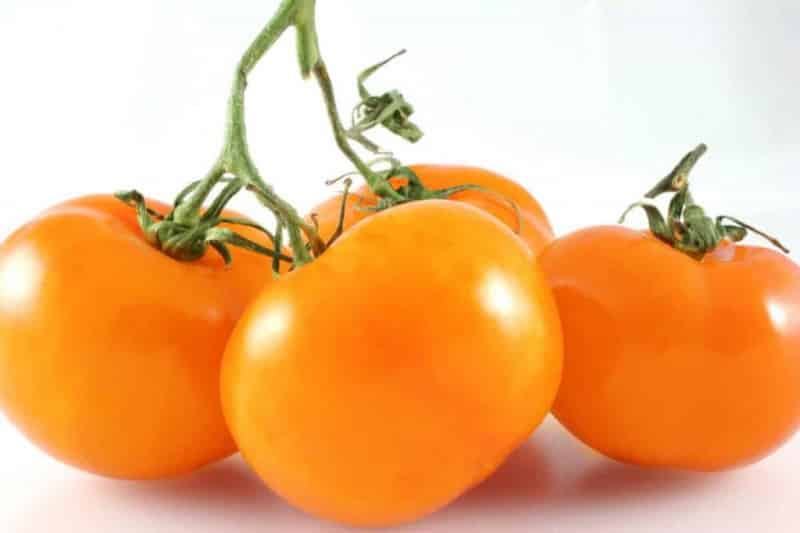
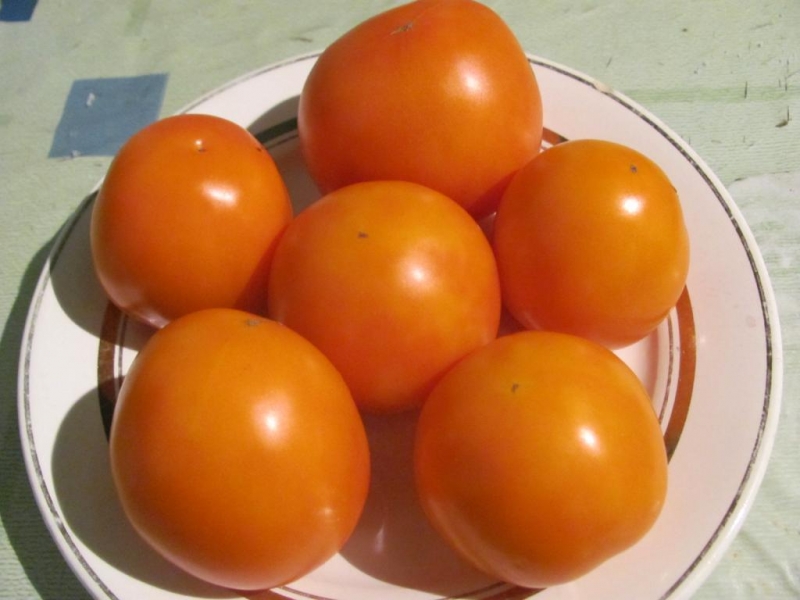
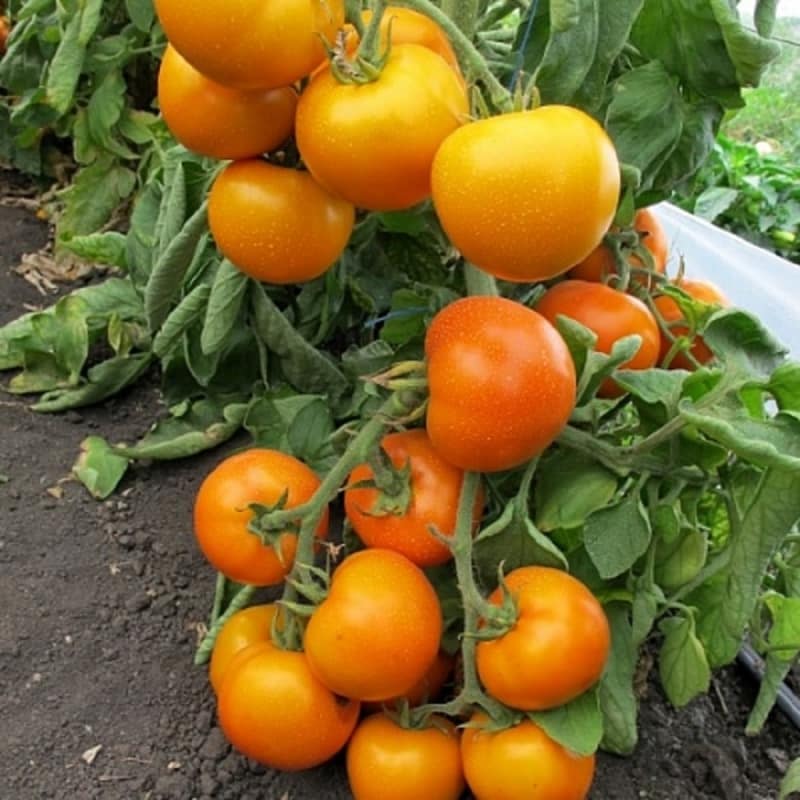
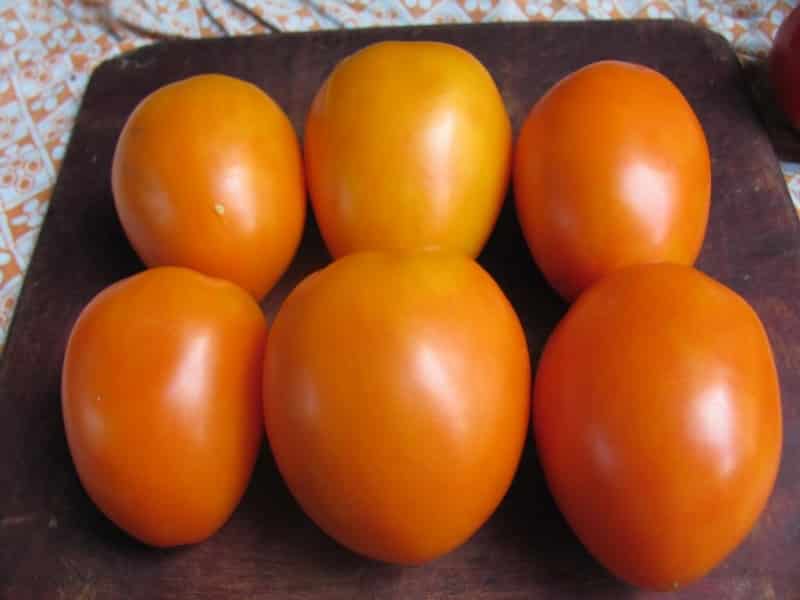
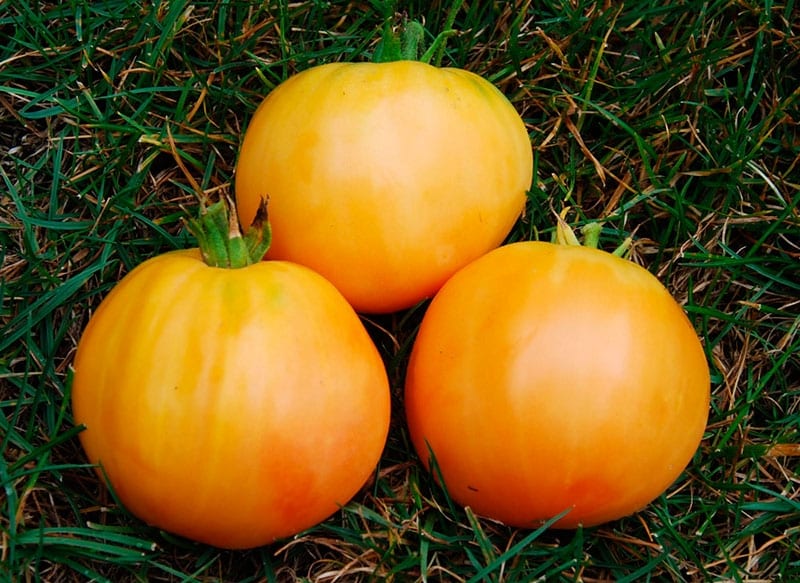
How to get seedlings
Designed for outdoor cultivation, but also possible in greenhouses (better than film ones). Everything from the moment of sprouting to the ripening of tomatoes takes 85-90 days.
Approximately 9-12 days for planting and establishment of seedlings, plus 2 months for seedling germination (45-55 days) and several weeks for fruit ripening.
For open ground, seedlings are prepared from mid-March or in the 1st ten days of April.
Seed preparation:
- Dry seeds need to be washed in potassium permanganate. To prepare a solution (0.5%) you will need 200 ml of water and 1 gram of pharmaceutical manganese in crystals.
- Leave them in it for 15-20 minutes and rinse with plenty of water.
- Then soak for a couple of hours in a hormonal extract to accelerate germination for 4-5 days.
 These manipulations will increase survival rate and protect seedlings from diseases in the first few weeks.
These manipulations will increase survival rate and protect seedlings from diseases in the first few weeks.
Although, you can do without pre-sowing treatment, if you are sure that this is a proprietary product in a closed shell, it was stored correctly and did not miss the expiration date.
Next, the seeds are placed in a separate container with water, which is covered with gauze so that they do not float.
Container and soil
The container for seedlings can be any, even a large container, even individual 100 ml pots. The distance between seedlings is small (from 2 cm), the roots are poorly developed, but the main thing is that sufficient oxygen access is ensured. And after the first two true leaves appear, the roots begin to grow and require 4 times more space. Transplant into containers or individual pots up to 500 ml.
Sowing:
- There is no need to wait for the seed to germinate and, on the second day, plant it in special universal fertile soil about 2 cm deep.
- It is important that the sprout itself sheds its skin after sprouting outward, so each hole needs to be lightly compacted.
- The sowing is covered with film, but care is taken to ensure that the seeds do not steam. The temperature must be at least 15°C and no more than 25°C.
- When the shoots appear, the film is removed and the temperature is reduced to 16° C during the day and 14° C at night, this is done for the full growth and development of the root system. It is these temperature indicators that contribute to the proper absorption of minerals.
It is important that there is enough not only moisture, but also light. In February-March, seedlings should be illuminated for at least 12 hours during the day.
Aftercare
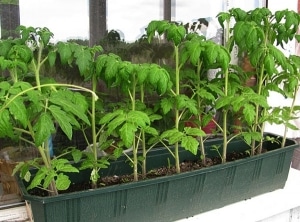 In the next stage, the plants are transplanted into new pots, at the same time diving the roots (by 1-2 cm) to grow in width and the appearance of lateral shoots. This is an important point.
In the next stage, the plants are transplanted into new pots, at the same time diving the roots (by 1-2 cm) to grow in width and the appearance of lateral shoots. This is an important point.
Reducing part of the root system makes the plant older and speeds up the ripening period of tomatoes.
- 2 hours before transplanting, the soil needs to be moistened in order to remove the sprout more carefully. A teaspoon or toothpick is used as a tool.
- Immediately after picking and transplanting, it is necessary to start feeding with nutritional mixtures, and to increase the mass of the roots, lower the temperature. Therefore, the pots are moved to a dark place for a couple of days.
- A week or two before transplanting into open ground, young plants are hardened off by taking them out into the open air for several hours, fertilized less with nitrogen and watering is reduced.
How to grow tomatoes
The seedlings must be at least 50 days old, and the soil (at a depth of 12 cm) must be warmed to at least 12 C day and night.
At the time of transplantation, the seedlings already look quite strong, developed roots have entwined the entire pot, a thickened trunk, dark green leaves, a bud or a blossoming flower on the first cluster.
The planting site is chosen based on the sunniest and highest space on the site. Poor lighting reduces the sugar content and weight of the fruit.
Landing
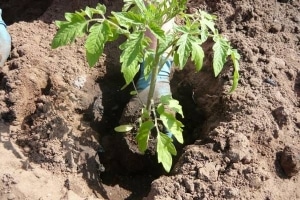 A damp and cloudy day or evening is best for transplanting.
A damp and cloudy day or evening is best for transplanting.
You can plant seedlings in a greenhouse or directly in open ground according to the 40x70 cm pattern.
The more stems, the greater the distance between bushes.
Disembarkation:
- A glass of ash, humus, and special complex fertilizers from the store are poured into the hole.
- Then fill it with water, maybe more than once, so that the consistency of the soil is like sour cream.
- The bush (possibly with a clod of earth) is planted deep to the level of the first true leaf.
- At the roots, the soil with the roots must be squeezed with your fingers.
- Stepchildren (shoots from the axils of the stem) need to be removed, even very small ones.
The best bushes are planted in a row, and it is better to leave the weak ones at the edges. It is important to be careful, as infection can easily enter through injured roots.
Care
It is recommended to mulch with dry grass, shavings, husks, sawdust, straw or inorganic materials (polyethylene with holes, agrofibre, etc.). A protective layer of mulch fights pests and weeds, prevents overheating and compaction.
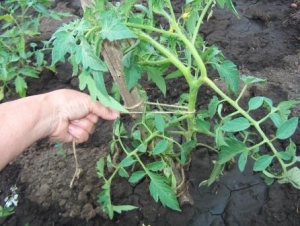 Each stem needs a garter. In order not to damage the roots, the peg should be at a distance (15-20 cm) and higher than the bush. The trunk is tied around the stems with ropes or ribbons crossed in a figure eight.
Each stem needs a garter. In order not to damage the roots, the peg should be at a distance (15-20 cm) and higher than the bush. The trunk is tied around the stems with ropes or ribbons crossed in a figure eight.
There is no need to water or loosen the first 10 days after planting tomatoes.
Hilling is scheduled for the second week after transplantation.
- In the early morning (2 hours before dawn) or late evening, water the soil so that it is soft enough.
- Weeds are pulled out by hand.
- Loosen with a convenient tool.
- Sprinkle the trunk with a mound of loose earth in the form of a mound of about 20 cm.
This process is usually combined with humus fertilizer. You can repeat the activity every week after watering or rain.
Fertilizing with any microelements is done when the first true leaf appears., spray 2-3 hours after watering. There is no need to fill the tomatoes. Once every 5-10 days is enough, depending on the weather, and if you notice that the leaves are a little wilted.
Possible difficulties
From an excess of water, the seeds begin to suffocate, so the seedling pots should spill through, and the excess water should flow freely into the pan. Water only with warm, settled (without bleach) clean water.
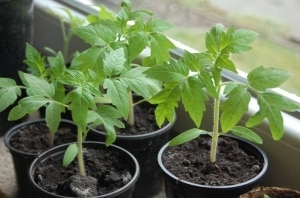 It is useful to unfold and swap pots to change the lighting angle. You can also put something under them if the window sill is cold. Correct actions in the initial period of caring for seedlings are actually much more important than all other activities with an adult plant.
It is useful to unfold and swap pots to change the lighting angle. You can also put something under them if the window sill is cold. Correct actions in the initial period of caring for seedlings are actually much more important than all other activities with an adult plant.
You cannot plant tomatoes next to potatoes, because they are the first to be affected by late blight. Excess dampness and moisture can cause flowers to fall off, delayed fruit set and the appearance of fungus. 3-5 liters of water per bush is enough, and during flowering generally reduce watering to 1-2 liters. But they don’t like to drink tomatoes more than twice a week.
Diseases and pests
Prone to late blight - the fruits are covered with brown and brown spots, the stems and leaves have dark stripes, and the bottom of the leaf is covered with a white fungal coating. They are treated with special preparations – fungicides. Picked fruits can also be susceptible to fungus.
Prevention consists of moderate amounts of fertilizer and water.. Avoid crowding of bushes and immediately remove and burn all diseased plants.
Parasites like to eat leaves and stems:
- Colorado potato beetles;
- slugs;
- spider mites;
- whiteflies;
- caterpillars;
- aphid.
Insecticides are used to control insects.
Nuances for open ground and greenhouses
When growing in a greenhouse, avoid condensation and ventilate from the direction opposite to the wind direction. If it rains, the greenhouse is not watered. Excess moisture directly affects the taste, making tomatoes more bland.
Harvesting and application
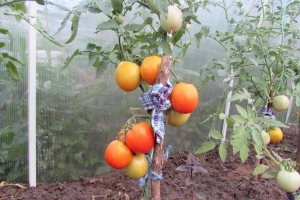 The first harvest of Golden Mother-in-law tomatoes occurs in mid-to-late July. Fruiting lasts, depending on the region and place of planting (greenhouse, soil), until mid-October.
The first harvest of Golden Mother-in-law tomatoes occurs in mid-to-late July. Fruiting lasts, depending on the region and place of planting (greenhouse, soil), until mid-October.
When there is a threat of frost, harvesting semi-ripe fruits is allowed. Ripening (ripening) is possible on racks and in boxes in a maximum of three layers at t +20-25 °C and relative humidity up to 80%.
They are not stored for very long, on average up to 1.5 months at +5° C, and are transported well.Universal for consumption both fresh and for preparing tomato juice, spaghetti and meat sauce, ketchup, canned and fresh salads.
Advantages and disadvantages
The variety combines many positive qualities. Starting from an appetizing appearance and ending with high yield under not the most favorable conditions of the Russian summer.
- Does not cause allergies, is universal when used.
- Excellent for diet and children's menus due to the increased content of antioxidants.
- It has immunostimulating and adaptogenic properties.
The disadvantage is that Seeds cannot be collected from hybrid fruits, because they produce completely different and often non-viable plants. Seeds are obtained by crossing two varieties, which means only from first generation seeds. To get them you have to pollinate the opened flowers by hand.
Farmer reviews
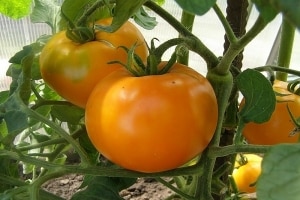 Many gardeners have already tried this variety for growing on their site and were satisfied with the result. Among the positive qualities, the following stand out:
Many gardeners have already tried this variety for growing on their site and were satisfied with the result. Among the positive qualities, the following stand out:
- high quality taste;
- tomatoes ripen quite quickly;
- interesting appearance of the fruit;
- high productivity;
- immunity to certain types of diseases of vegetable crops.
Directly similar reviews about the Golden Mother-in-law tomato can be heard from people who have dealt with the tomatoes described.
Conclusion
The “Golden Mother-in-Law” tomato is grown in various regions of the country in open or closed ground. Easy care, which consists of moderate watering, fertilizing, loosening the soil, will be rewarded with a rich harvest of tasty and colorful fruits.
“Golden Mother-in-Law” is an unpretentious, productive hybrid.Its undeniable advantages include early ripening, pleasant taste of fruits, and their appearance. A distinctive feature of the variety is the high content of beta-carotene in the fruits.
We invite you to watch a video about the Golden Mother-in-law tomato variety: